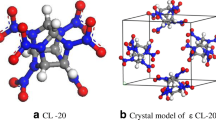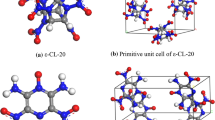Abstract
The crystal models of trans-1,4,5,8-tetranitro-1,4,5,8-tetraazadecalin (TNAD), hexanitrohexaazaisowurtzitane (CL-20), and CL-20/TNAD cocrystal explosive with different component ratios were established. Molecular dynamics (MD) method was applied to predict the stability, sensitivity, energetic properties, and mechanical properties. The effect of component ratio on properties of CL-20/TNAD cocrystal explosive was investigated and estimated. Results show that the cocrystal model with component ratio in 1:1 exhibits the highest binding energy and it is more stable. In CL-20/TNAD cocrystal explosive, the interaction energy of trigger bond is increased by 0.8 ~ 15.0 kJ/mol, implying that the mechanical sensitivity of CL-20/TNAD cocrystal explosive is lower than CL-20 and the safety is effectively improved. Compared with raw CL-20, the crystal density of cocrystal explosive is declined by 0.014 ~ 0.193 g/cm3, detonation velocity is declined by 39 ~ 755 m/s, and detonation pressure is declined by 0.95 ~ 11.40 GPa; namely the energy density of CL-20/TNAD cocrystal explosive is lower than CL-20. The cocrystal explosives with component ratio in 10:1 ~ 1:1 still exhibit desirable detonation performance and can be regarded as high energy density explosives. The values of tensile modulus, shear modulus, and bulk modulus of CL-20/TNAD cocrystal explosive are decreased by 0.448 ~ 10.285 GPa, 0.195 ~ 4.189 GPa, and 0.194 ~ 6.292 GPa, respectively, Cauchy pressure is increased by 0.990 ~ 5.704 GPa, meaning that the rigidity, fracture strength, and hardness of cocrystal explosive are declined, while the plastic property and ductility are increased and the mechanical properties are improved. The cocrystal model with component ratio in 1:1 has the best mechanical properties. Consequently, the CL-20/TNAD cocrystal explosive with component ratio in 1:1 is more stable and insensitive; it also has high energy density and the best mechanical properties and may be an attractive candidate for high energy explosives.







Similar content being viewed by others
Data availability
All data generated or analyzed during this study are included in this article.
Code availability
Not applicable.
References
Lara OF, Espinosa PG (2007) Cocrystals definitions Supramol Chem 19:553–557
Bond AD (2007) What is a co-crystal. CrystEngComm 9:833–834
Bolton O, Matzger AJ (2011) Improved stability and smart-material functionality realized in an energetic cocrystal. Angew Chem Int Ed 50:8960–8963
Yang ZW, Li HZ, Huang H, Zhou XQ, Li JS, Nie FD (2013) Preparation and performance of a HNIW/TNT cocrystal explosive. Propellants Explos Pyrotech 38:495–501
Bolton O, Simke LR, Pagoria PF, Matzger AJ (2012) High power explosive with good sensitivity: a 2:1 cocrystal of CL-20:HMX. Cryst Growth Des 12:4311–4314
Tan YW, Yang ZW, Wang HJ, Li HZ, Nie FD, Liu YC, Yu YW (2019) High energy explosive with low sensitivity: a new energetic cocrystal based on CL-20 and 1,4-DNI. Cryst Growth Des 19:4476–4482
Bennion JC, Siddiqi ZR, Matzger AJ (2017) A melt castable energetic cocrystal. Chem Commun 53:6065–6068
Landenberger KB, Bolton O, Matzger AJ (2013) Two isostructural explosive cocrystals with significantly different thermodynamic stabilities. Angew Chem Int Ed 52:6468–6471
Lin H, Chen JF, Zhu SG, Li HZ, Huang Y (2017) Synthesis, characterization, detonation performance, and DFT calculation of HMX/PNO cocrystal explosive. J Energ Mater 35:95–108
Chen PY, Zhang L, Zhu SG, Cheng GB, Li NR (2017) Investigation of TNB/NNAP cocrystal synthesis, molecular interaction and formation process. J Mol Struct 1128:629–635
Liu N, Duan BH, Lu XM, Zhang Q, Xu MH, Mo HC, Wang BZ (2019) Preparation of CL-20/TFAZ cocrystals under aqueous conditions: balancing high performance and low sensitivity. CrystEngComm 21:7271–7279
Nielsen AT, Chafin AP, Christian SL, Moore DW, Nadler MP, Nissan RA, Vanderah DJ, Gilardi RD, George CF, Flippen-Anderson JL (1998) Synthesis of polyazapolycyclic caged polynitramines. Tetrahedron 54:11793–11812
Willer RL (1983) Synthesis and characterization of high energy compounds. I. trans-1,4,5,8-tetranitro-1,4,5,8-tetraazadecalin (TNAD). Propellants Explos Pyrotech 8:65–69
Foltz MF, Coon CL, Garcia F, Nichols AL (1994) The thermal stability of the polymorphs of hexanitrohexaazaisowurtzitane, part I. Propellants Explos Pyrotech 19:19–25
Agrawal JP (2005) Some new high energy materials and their formulations for specialized applications. Propellants Explos Pyrotech 30:316–328
Zhao XQ, Shi NC (1995) Crystal structure of ε-hexanitrohexaazaisowurtzitane. Chin Sci Bull 40:2158–2160
Feng RZ, Zhang SH, Ren FD, Gou RJ, Gao L (2016) Theoretical insight into the binding energy and detonation performance of ε-, γ-, β-CL-20 cocrystals with β-HMX, FOX-7, and DMF in different molar ratios, as well as electrostatic potential. J Mol Model 22:123
Wu ZK, Shu YJ, Liu N, Ding XY, Wu MJ, Wang K, Wang B, Lu YY (2016) Molecular dynamics simulation of CL-20/FOX-7 co-crystal. Chin J Explos Propellants 39:37–42
Sun H, Ren PJ, Fried R (1998) The COMPASS force field: parameterization and validation for phosphazenes. Comput Theor Polym Sci 8:229–246
Michael JM, Sun H, Rigby D (2004) Development and validation of COMPASS force field parameters for molecules with aliphatic azide chains. J Comput Chem 25:61–71
Bunte SW, Sun H (2000) Molecular modeling of energetic materials: the parameterization and validation of nitrate esters in the COMPASS force field. J Phys Chem B 104:2477–2489
Xu XJ, Xiao JJ, Huang H, Li JS, Xiao HM (2010) Molecular dynamics simulations on the structures and properties of ε-CL-20 (0 0 1)/F2314 PBX. J Hazard Mater 175:423–428
Xu XJ, Xiao HM, Xiao JJ, Zhu W, Huang H, Li JS (2006) Molecular dynamics simulations for pure ε-CL-20 and ε-CL-20-based PBXs. J Phys Chem B 110:7203–7207
Qiu L, Zhu WH, Xiao JJ, Zhu W, Xiao HM, Huang H, Li JS (2007) Molecular dynamics simulations of trans-1,4,5,8-tetranitro-1,4,5,8-tetraazadecalin-based polymer-bonded explosives. J Phys Chem B 111:1559–1566
Qiu L, Xiao HM, Zhu WH, Xiao JJ, Zhu W (2006) Ab initio and molecular dynamics studies of crystalline TNAD (trans-1,4,5,8-tetranitro-1,4,5,8-tetraazadecalin). J Phys Chem B 110:10651–10661
Casewit CJ, Colwell KS, Rappé AK (1992) Application of a Universal force field to organic molecules. J Am Chem Soc 114:10035–10046
Rappé AK, Colwell KS, Casewit CJ (1993) Application of a Universal force field to metal complexes. Inorg Chem 32:3438–3450
Mayo SL, Olafson BD, Goddard WA III (1990) Dreiding: a generic force field for molecular simulations. J Phys Chem B 94:8897–8909
Sun H (1994) Force field for computation of conformational energies, structures, and vibrational frequencies of aromatic polyesters. J Comput Chem 15:752–768
Bowden FP, Yoffe AD, Hudson GE (1952) Initiation and growth of explosion in liquids and solids. Cambridge University Press, Cambridge
Kamlet MJ, Adoiph HG (1979) The relationship of impact sensitivity with structure of organic high explosives. Propellants Explos Pyrotech 4:30–34
Xiao JJ, Wang WR, Chen J, Ji GF, Zhu W, Xiao HM (2012) Study on the relations of sensitivity with energy properties for HMX and HMX-based PBXs by molecular dynamics simulation. Physica B 407:3504–3509
Xiao JJ, Li SY, Chen J, Ji GF, Zhu W, Zhao F, Wu Q, Xiao HM (2013) Molecular dynamics study on the correlation between structure and sensitivity for defective RDX crystals and their PBXs. J Mol Model 19:803–809
Sun T, Xiao JJ, Liu Q, Zhao F, Xiao HM (2014) Comparative study on structure, energetic and mechanical properties of a ε-CL-20/HMX cocrystal and its composite with molecular dynamics simulation. J Mater Chem A 2:13898–13904
Xiao JJ, Zhao L, Zhu W, Chen J, Ji GF, Zhao F, Wu Q, Xiao HM (2012) Molecular dynamics study on the relationships of modeling, structural and energy properties with sensitivity for RDX-based PBXs. Sci China Chem 55:2587–2594
Xu XJ, Xiao HM, Ju XH, Gong XD (2005) Theoretical study on pyrolysis mechanism for ε-hexanitrohexaazaisowurtzitane. Chin J Org Chem 25:536–539
Geetha M, Nair UR, Sarwade DB, Gore GM, Asthana SN, Singh H (2003) Studies on CL-20: the most powerful high energy material. J Therm Anal Calorim 73:913–922
Guo YX, Zhang HS (1983) Nitrogen equivalent coefficient and revised nitrogen equivalent coefficient equations for calculating detonation properties of explosives: detonation velocity of explosives. Explos Shock Waves 3:57–65
Xu XJ, Xiao HM, Ju XH, Gong XD, Zhu WH (2006) Computational studies on polynitrohexaazaadmantanes as potential high energy density materials (HEDMs). J Phys Chem A 110:5929–5933
Xu XJ, Xiao JJ, Huang H, Li JS, Xiao HM (2007) Molecular dynamics simulations on the structures and properties of ε-CL-20-based PBXs-primary theoretical studies on HEDM formulation design. Sci China Ser B Chem 50:737–745
Wu JL (1993) Mechanics of elasticity. Tongji University Press, Shanghai
Weiner JH (1983) Statistical mechanics of elasticity. John Wiley, New York
Watt JP, Davies GF, O’Connell RJ (1976) The elastic properties of composite materials. Rev Geophys Space Phys 14:541–563
Funding
This research was supported by Young Talent Fund of University Association for Science and Technology in Shaanxi, China (grant number 20200604). HANG Gui-yun has received research support from the University Association for Science and Technology in Shaanxi.
Author information
Authors and Affiliations
Contributions
HANG Gui-yun: writing—original draft, formal analysis, investigation, and methodology.
WANG Jin-tao: data curation, methodology, and writing—review and editing.
WANG Tao: methodology, software, and writing—review and editing.
SHEN Hui-ming: writing—review and editing.
YU Wen-li: data curation, writing—review and editing, and visualization.
SHEN Rui-qiang: investigation, methodology, and writing—review and editing.
Corresponding author
Ethics declarations
Competing interests
The authors declare no competing interests.
Additional information
Publisher's Note
Springer Nature remains neutral with regard to jurisdictional claims in published maps and institutional affiliations.
Rights and permissions
About this article
Cite this article
Hang, Gy., Wang, Jt., Wang, T. et al. Theoretical investigations on stability, sensitivity, energetic performance, and mechanical properties of CL-20/TNAD cocrystal explosive by molecular dynamics method. J Mol Model 28, 58 (2022). https://doi.org/10.1007/s00894-022-05049-3
Received:
Accepted:
Published:
DOI: https://doi.org/10.1007/s00894-022-05049-3




